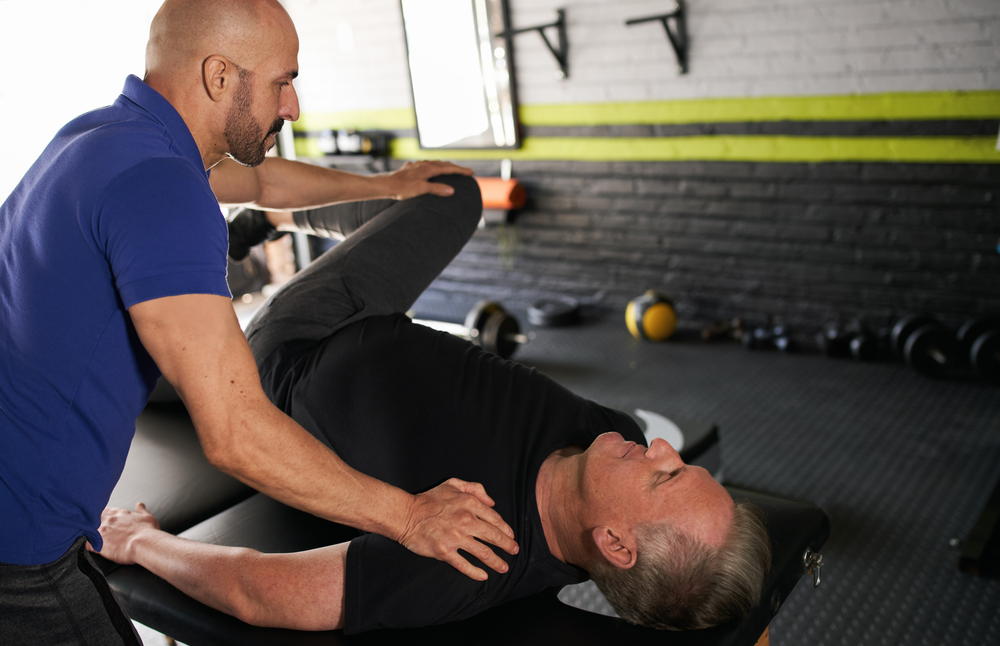Ever feel like your body just isn’t as flexible as it used to be? You’re not alone. More than 80% of adults experience some form of muscle stiffness or discomfort due to a lack of flexibility. This is why assisted stretching can be helpful for your mobility challenges.
But what exactly is assisted stretching, and how can it help you achieve a more flexible, stress-free body? In this guide, we’ll dive into everything you need to know, from its benefits to specific exercises, and why a trained professional can elevate your stretching routine.
What Is Assisted Stretching?
Assisted stretching is a technique where a trained professional helps guide your body through specific stretches. This process involves passive stretches, where you relax while someone else manipulates your muscles to increase their length and flexibility. Unlike self-stretching, assisted stretching allows you to target deeper muscle groups, ensuring that you stretch the right muscles with proper form and avoiding injury.
One of the key benefits of assisted stretching is that it provides a more thorough stretch, as the practitioner can help you go beyond your natural range of motion safely.
How Does Assisted Stretching Work?
During an assisted stretch therapy session, the practitioner will apply gentle pressure to your limbs while guiding your body into various stretching positions. The goal is to loosen up tight muscles, improve flexibility, and reduce discomfort. The stretching specialist ensures that the movements are safe and gradual, avoiding the risk of overstretching.
Practitioners use techniques such as proprioceptive neuromuscular facilitation (PNF) stretching, which involves contracting and relaxing muscles during a stretch to deepen the flexibility. Sessions typically last 30 to 60 minutes, focusing on different muscle groups or providing full body assisted stretching based on individual needs.

When to Stretch
It’s important to understand when to stretch for the best results. Assisted stretching can be incorporated into your fitness routine at various times of the day, depending on your needs.
Before Exercise
Stretching before a workout helps warm up your muscles, preparing them for physical activity. It can also help prevent injury by increasing blood flow and improving flexibility in key muscle groups.
After Exercise
Post-workout stretching is essential to help muscles recover, reduce soreness, and prevent stiffness. By elongating muscles after exertion, you can enhance muscle repair and flexibility.
After Sitting & Before Bed
Many people suffer from muscle stiffness due to long periods of sitting. Stretching after sitting for long hours can relieve tight muscles and improve circulation. Additionally, stretching before bed can help relax your muscles, promoting better sleep quality.
Benefits of Assisted Stretching with a Trained Professional
There are numerous benefits of assisted stretching when working with a trained professional. Here are a few key advantages:
Consistency and Proper Guidance
Having a professional guide your stretching routine ensures consistency, which is crucial for long-term flexibility improvements. They also provide proper instruction, minimizing the risk of injury.
Helps Reduce Muscle Stiffness
Stretching with assistance can target deep muscle tissues that are hard to reach through self-stretching. This reduces muscle stiffness, making everyday movements more comfortable.
Decrease Stress Levels
Stretching helps release tension in the muscles, and when done in a calming, guided environment, it can have a significant impact on lowering overall stress levels.
Helps With Flexibility
One of the primary goals of assisted stretch therapy is to enhance flexibility. Over time, regular sessions will allow you to move more freely and with greater ease, improving posture and mobility.
Enhances Athletic Performance
For athletes, flexibility is key to preventing injury and enhancing performance. By regularly incorporating assisted stretching exercises into your routine, you can optimize your range of motion and improve coordination, strength, and endurance.
What Are Examples of Assisted Stretching Exercises?
Assisted stretching can target various muscle groups to ensure full-body flexibility. Here are a few common stretches that are often incorporated into a full-body-assisted stretching session:
Stretching Your Hamstrings
In this stretch, the practitioner gently lifts your leg while keeping your knee straight. This helps to lengthen the hamstring muscles, improving flexibility in your hips and legs.
Stretch for Your Quads
While lying face down, the professional bends your knee toward your back, stretching the quad muscles. This stretch is great for relieving tension after leg-intensive exercises like running or cycling.
Stretch for Your Chest
To stretch the chest, you may lie on your back while the practitioner extends your arms outward. This stretch helps open up the chest and shoulders, improving posture and relieving tension caused by prolonged sitting.

Incorporating Stretching as Part of Your Fitness Routine
If you want to experience the long-term benefits of stretching, it’s important to incorporate it into your daily routine. Assisted stretching complements other fitness activities such as strength training, cardio, and flexibility exercises like yoga.
One tip for making stretching a habit is to schedule it just like any other workout. You can even pair it with other forms of exercise, such as a 30-minute stretching session followed by strength training or cardiovascular activity.
Finding a Qualified Assisted Stretching Service Practitioner
It’s crucial to find a qualified professional who understands your body’s unique needs and goals when seeking an assisted stretching service. Here are some tips you can try when looking for a stretching specialist:
Set Realistic Goals
Before starting, set realistic flexibility and mobility goals with your stretching practitioner. Whether you’re targeting chronic stiffness or trying to improve athletic performance, having a clear goal will help guide your sessions.
Create a Routine
Once you begin assisted stretch therapy, create a regular routine. Consistency is key to achieving long-lasting flexibility and mobility improvements.
Listen to Your Body
It’s important to pay attention to how your body responds to each session. If you feel any discomfort or pain, communicate that with your practitioner. Assisted stretching should not be painful.
Supplement with Other Forms of Exercise
While stretching is essential for flexibility, it’s important to balance it with strength training and cardiovascular activities for a well-rounded fitness routine.
Visit SolCore Wellness in Cypress for an Assisted Stretching Service
Looking for a certified professional to help you achieve your stretching goals? Visit SolCore Wellness in Cypress, TX.
SolCore Wellness offers specialized wellness services, including assisted stretching service in Cypress, TX. With certified experts who provide one-on-one stretch therapy sessions, SolCore Wellness focuses on improving flexibility, reducing muscle tension, and enhancing overall wellness. Their comprehensive wellness packages include not just stretching but also compression therapy, sauna therapy, and intravenous therapy, ensuring a full-body wellness experience.
To book your session, visit us at 11403 Barker Cypress Rd Suite 800, Cypress, TX 77433, or check out our wellness packages only at SolCore Wellness. Explore our full range of offerings, from 1-on-1 stretching to wellness packages tailored to your needs. Book your session with SolCore Wellness today.
